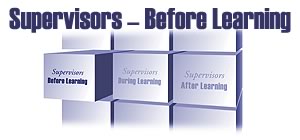|
|||||||||||||||||||||||||||||||
Understand the performance needConducting a performance needs assessment is an important step in enabling supervisors to fully understand the nature of the performance needs at their facilities. Supervisors should ask themselves: "What is the desired performance? Is there a gap between what the staff is actually doing and what they should be doing? Do I understand the root causes of this gap? Is training the right solution to improve job performance?" Although training is a popular intervention for improving job performance, other interventions might be more appropriate. Before you embark on a training intervention, be sure that training is the right solution for the problem. Participate in any additional assessments required for trainingAn additional needs assessment may be conducted by trainers to ensure that the goals and objectives of a learning intervention will meet the identified performance needs of the learners. In order to design and develop the most effective intervention, trainers often require additional information that would not be gathered during a performance needs assessment (e.g., specific learner characteristics such as the reading level of learners or current skill level of each learner on a specific task). As a supervisor, you have unique knowledge of staff members' on-the-job performance and can describe the specific gaps in knowledge and skills that a training intervention needs to address.
By actively participating in additional assessments, you will help guarantee that the resulting training will have the desired effects. Influence selection of learnersSelecting the appropriate staff members for training is an important part of ensuring the effectiveness of a training intervention. Participate in staff selection as much as possible and involve staff by discussing who should attend and why. As you think about whom to send for training, consider the following:
Communicate with trainers about the learning interventionSupervisors who are aware of the content of the training can model desired behaviors, better explain post-training expectations to staff and reinforce desired behaviors after training. Awareness of the content of training can come from reviewing the course materials, receiving an orientation from the trainer and observing or participating in parts of the learning intervention. Such interaction between supervisors and trainers allows learners to see that their supervisors are committed to the learning intervention and interested in the entire process. Communicating with the trainers also provides an opportunity for supervisors to make sure that the trainers understand the performance need. Working with the trainers, you can determine what will maximize the event for the learners. Help learners create a preliminary action planCommunicate positive messages to learners about the importance of training. Identify and share with them specific expectations about performance. Before the training activity, ask the learners what they hope to get out of the training. Then explain precisely what you anticipate they will be able to do for your facility with their new knowledge and skills. Supervisors can help learners understand how their new knowledge and skills contribute to the goal of improving health care by working with the learners to develop action plans. Supervisors and learners can begin preliminary work on an action plan at their job sites prior to the training event. Discussing the action plan gives both supervisors and learners a chance to clarify expectations related to the training. Generally, learners will further refine their action plans with the help of a trainer. Supervisors can then complete the action plans with the learners after the training event. See examples of a blank and completed action plan. Support and encourage learnersOnce supervisors decide who will attend the training, it is important to provide those learners with the support they need.
(Note: Unless learners have been trained to train others, they should not be expected to train their co-workers in the skills they will learn, especially complex clinical procedures.) | |||||||||||||||||||||||||||
